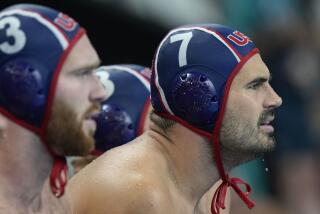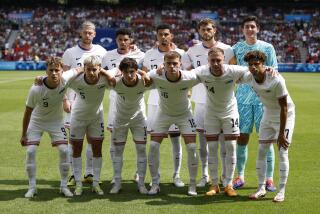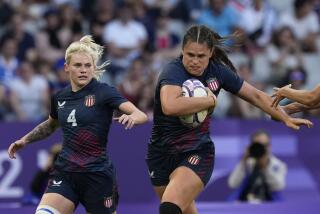These U.S. rugby sevens speedsters help carry momentum into Olympics
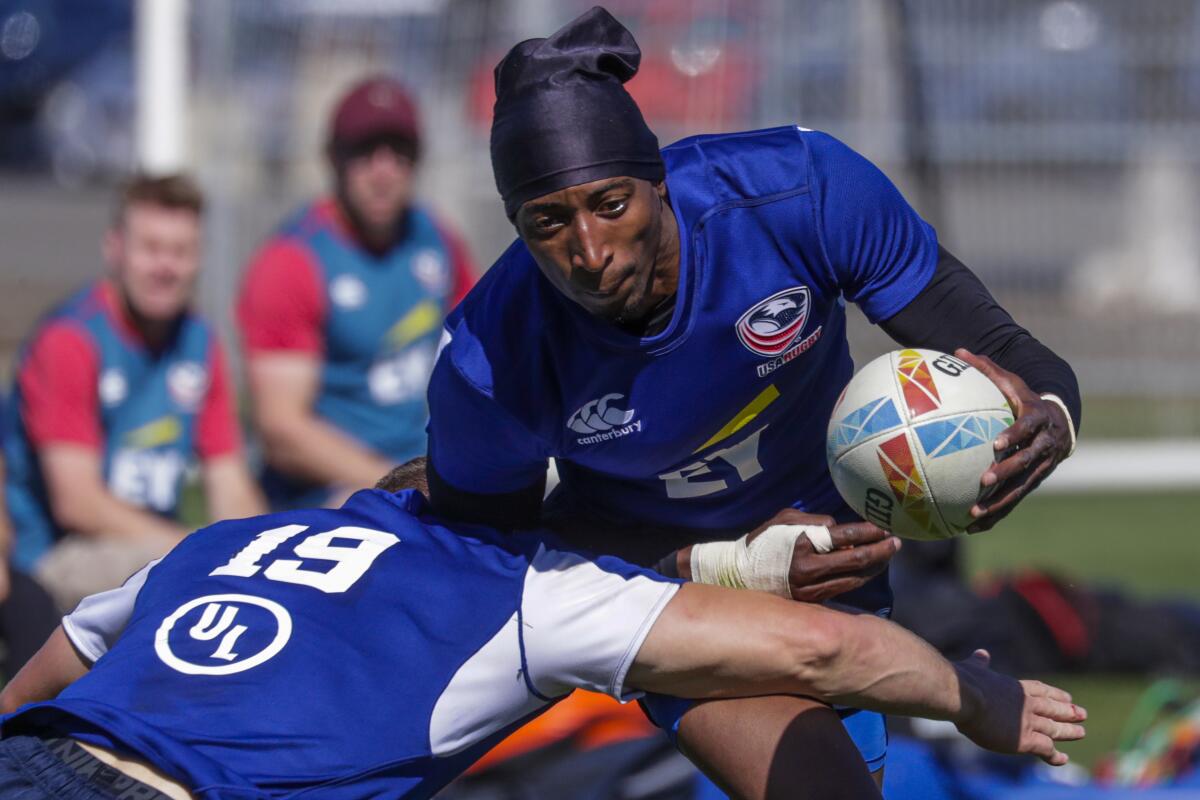
The two fastest players in the U.S. rugby program are usually the last guys to board the team bus. The last ones to arrive at meetings. The last onto the practice field.
Their coaches devised a penalty system for their tardiness that involves dice. Rolling a two means that Carlin Isles and Perry Baker must buy doughnuts for the rest of the squad. Four requires them to post shirtless pictures, with apologies, on social media.
In terms of behavior modification, the impact on the so-called ‚ÄúSlow Bros‚ÄĚ has been limited.
‚ÄúWe‚Äôve gotten better,‚ÄĚ Baker says. ‚ÄúBut were still the last ones.‚ÄĚ
Not that it really matters, because the pure speed that Isles and Baker display on the field has helped transform the Americans into a contender on the international scene, battling traditional powerhouses such as New Zealand, South Africa and Fiji.
The U.S. Eagles have made their mark in rugby sevens, a hyper-speed version of the conventional 15-man game that features tons of open space and all-out sprinting.
This weekend, the Americans enter the HSBC World Rugby Sevens tournament at Dignity Health Sports Park ranked No. 6 in the world and guaranteed a spot at the 2020 Summer Olympics.
‚ÄúI think we‚Äôve seen a huge development curve,‚ÄĚ says Alex Corbisiero, a former British national player who serves as analyst on NBC Sports broadcasts. ‚ÄúThey‚Äôve shown they are a medal-caliber team.‚ÄĚ
The emergence of U.S. rugby coincides with the maturation of two wings who have become the first American superstars in the sport, despite starting relatively late in life.
The 30-year-old Isles was a sprinter, built short with thick legs that now propel him through tight spaces. The 33-year-old Baker was a football receiver, long and lithe, who specializes in gaining separation from defenders.
‚ÄúWe each bring something a little different,‚ÄĚ Isles says. ‚ÄúOther teams have to adapt.‚ÄĚ
::
In the spring of 2012, Isles was preparing for the Olympic trials, hoping to make the U.S. track team headed for London.
As a student of sprinting ‚ÄĒ ‚Äúa process guy,‚ÄĚ he says ‚ÄĒ the 5-foot-8 Ohio native knew that at 10.13 seconds, his 100-meter best was fast but not quite fast enough. Surfing the internet, looking for videos on technique, he stumbled upon highlights from a different kind of sport.
‚ÄúIt just sort of popped up on YouTube,‚ÄĚ he recalls. ‚ÄúI was like, what if I was the fastest rugby player in the world?‚ÄĚ
The game can appear odd to Americans. Players crouch down and lock shoulder-to-shoulder in scrums, pushing and grappling like wrestlers. When the fat, oval ball squirts out and all hell breaks loose with a series of underhand laterals, an all-out dash ensues to score a try, which is rugby’s version of a touchdown.
Intrigued by this action, Isles cold-called the U.S. federation and got invited to practice with a Colorado club run by one of national team’s assistant coaches. He left home with all of his possessions packed in his car and $500 in his wallet.
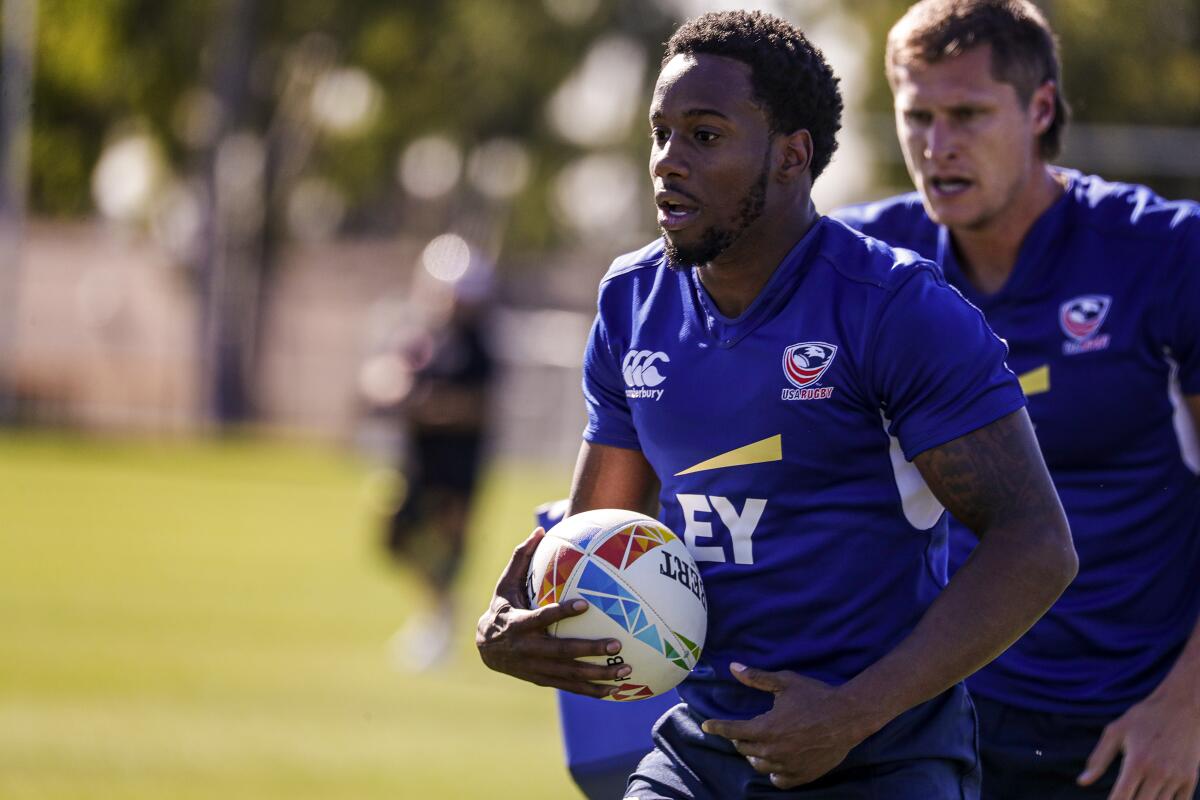
If rugby felt foreign ‚ÄĒ the rules and skills so different from anything he had ever experienced ‚ÄĒ it also felt good. His natural speed soon got him signed to a contract, practicing with the U.S. team in Chula Vista.
‚ÄúI thought wow,‚ÄĚ he says, ‚Äúthis might be made for me.‚ÄĚ
Around the same time, Baker was chasing dreams of playing in the NFL. The Philadelphia Eagles had shown interest in signing the 6-foot-1 receiver out of Fairmont State University, a Division II school, until they discovered he was playing with a torn meniscus.
Knee surgery, rehabilitation and two seasons in the now-defunct Arena Football League had him questioning his future.
‚ÄúI was getting older for football,‚ÄĚ he says. ‚ÄúI had to make up my mind.‚ÄĚ
Rugby emerged as a Plan B because he had played occasionally with a men’s club while growing up in Florida. Recalling how much fun that was, Baker started training at a rugby academy in Ohio.
The national team signed him in 2014 and, when he showed up at camp, Isles rushed over to help with unpacking.
In rugby, much of the hard, technical work is done by the big men up front. The wing is positioned at the back of the formation, looking to take a pass, make a move and dart for the tryline.
Isles and Baker found themselves competing for playing time ‚ÄĒ there is only one wing in rugby sevens ‚ÄĒ but became immediate friends. In addition to the ‚ÄúSlow Bros,‚ÄĚ they became known as the ‚ÄúChuckler Brothers‚ÄĚ and Tweedledee and Tweedledum.
Baker recalls that he needed a friend to help him acclimate to a new career.
‚ÄúI really didn‚Äôt know what I was getting myself into,‚ÄĚ he says. ‚ÄúI didn‚Äôt know the type of training they did. I was like, this is tougher than football.‚ÄĚ
::
After a lifetime of playing the sport, as well as coaching national teams in Britain and Kenya, Mike Friday suspects that it takes at least five years before an athlete starts thinking like a rugby player.
Friday took over the American sevens in 2014, hired to lift the young program to a world-class level. He got his squad into the 2016 Summer Olympics, but a ninth-place finish was hardly satisfying.
The problem was partly cultural ‚ÄĒ American sports often focus on individual confrontations, whether it‚Äôs a batter at the plate, a receiver trying to outrun a cornerback or a point guard beating a defender to the basket. Rugby is different.
‚ÄúEvery player needs to think and make decisions as a team,‚ÄĚ Friday says. ‚ÄúThat means there is more room for error.‚ÄĚ
Raw talent helped Isles and Baker earn playing time quickly, but they were only ‚Äúspeedsters‚ÄĚ at first. Fundamental skills such as making passes and kicking the ball through the goalposts ‚ÄĒ sometimes on the run ‚ÄĒ were difficult. The mental aspect of the game proved even more challenging.
‚ÄúYou‚Äôre shooting in the dark,‚ÄĚ Friday says. ‚ÄúThat‚Äôs tough for a young man.‚ÄĚ
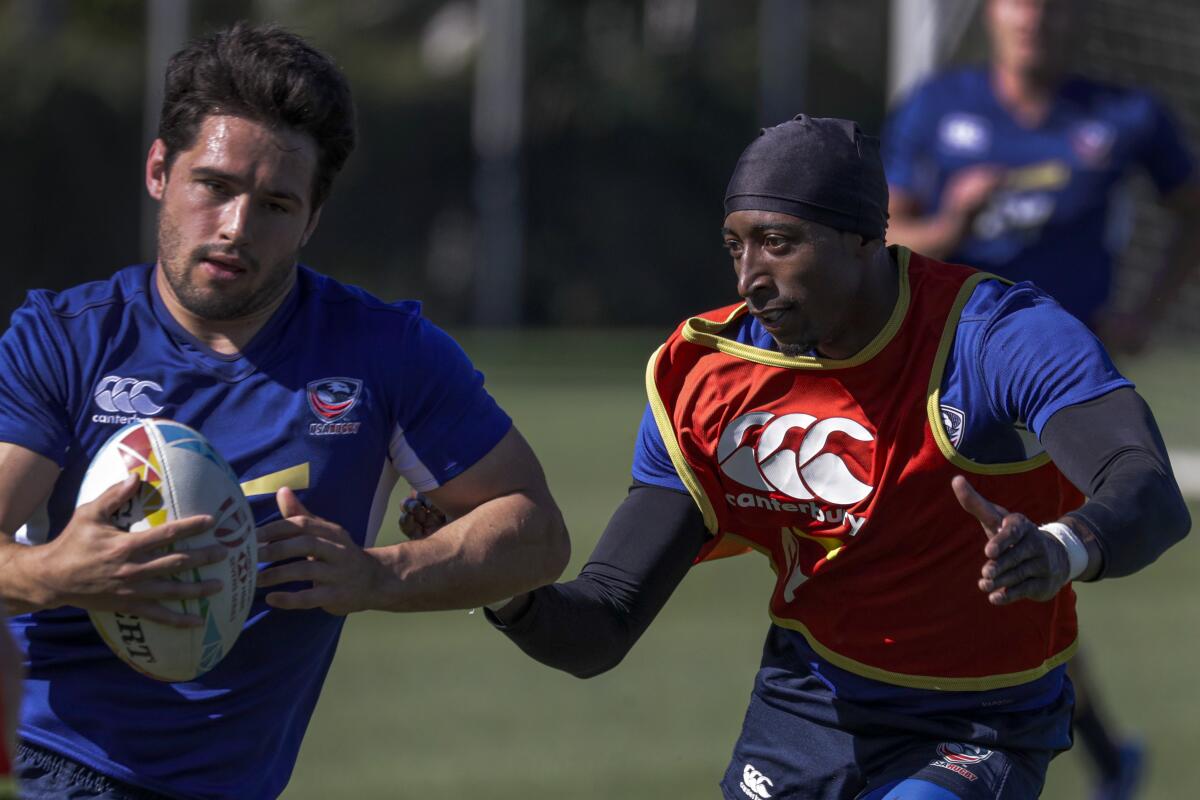
Neither Isles nor Baker gave any thought to quitting. In the seasons after the Rio Olympics, they continued to polish their games, improving alongside teammates such as Danny Barrett and Ben Pinkelman, who were also becoming world-class players.
For Isles, as a ‚Äúprocess‚ÄĚ guy, the learning curve included studying his new sport relentlessly, trying to understand positioning and angles of attack.
‚ÄúThe little details were the biggest jump for me,‚ÄĚ he says.
Baker needed something else. Worried that he was too slight for a sport where most players are bulky, he gained confidence from watching Cecil Afrika, the similarly built star of South Africa’s team. A broken jaw last season kept him out only a couple of months.
‚ÄúThe ‚Äėtoo small‚Äô thing,‚ÄĚ he says. ‚ÄúI got over that.‚ÄĚ
Baker was named HSBC World Rugby Sevens player of the year in 2017 and 2018. Isles led the circuit in scoring in 2018.
‚ÄúIt has taken time for them to mature into their games,‚ÄĚ says Ben Ryan, who coached Fiji to the gold medal in 2016. ‚ÄúWith that consistency, plus experience, they‚Äôve had success.‚ÄĚ
::
It makes sense that, as an accelerated version of the original game, rugby sevens is played in two, seven-minute halves with only a brief break. This abridged format allows tournaments to be contained within a weekend, teams playing all their pool matches on Saturday and completing the elimination round on Sunday.
The Los Angeles tour stop takes on added importance as teams prepare for the Summer Olympics. Tournaments in Singapore and Hong Kong have been postponed until next fall because of the coronavirus outbreak.
The Eagles enter this weekend hoping for a three-peat after winning this event ‚ÄĒ previously held in Las Vegas ‚ÄĒ the last two seasons. Much will depend on the offensive output from their star wingers.
‚ÄúYou basically have that one-two punch,‚ÄĚ Corbisiero says, adding, ‚ÄúI just think they bring an X factor that is almost unparalleled with any other team.‚ÄĚ
Each player owes a big part of his success to the other.
The American program showed its biggest improvement after Friday decided to alternate Isles and Baker, playing one in the first half, the other in the second. That meant the U.S. always had a fresh pair of legs at a crucial position, forcing defenders to adapt to slightly different styles.
Baker has a knack for finding open space, giving himself room to make moves and avoid tacklers, his coach says. Isles attacks the defense in a blunter, more physical way.
‚ÄúCarlin is a fighter,‚ÄĚ Friday says. ‚ÄúHe will go toe-to-toe.‚ÄĚ
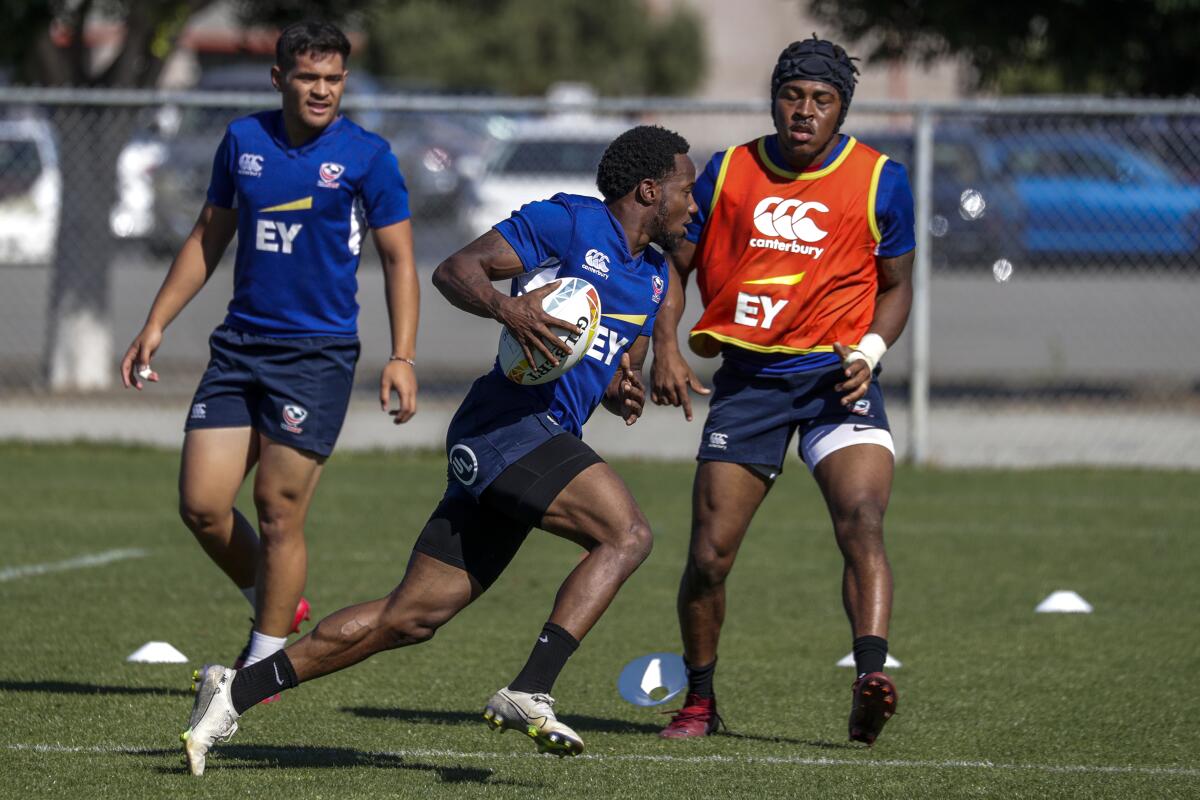
Last season, the U.S. led the HSBC series for much of the schedule before finishing second to Fiji. Ryan gives much of the credit to Isles and Baker, saying they can ‚Äúdo the spark stuff, the stuff that gets them on highlight tapes.‚ÄĚ
As of this week, Isles ranks third in the world with 14 tries for the 2020 season. Baker is close behind at 13. Neither man seems to worry much about splitting time.
‚ÄúI like it when we‚Äôre both clicking,‚ÄĚ Baker says. ‚ÄúIt becomes a little competition.‚ÄĚ
As defenses have focused on taking away the outside, the wings have worked at using the center of the field. Their continued development gives the U.S., which finished third at a Sydney tournament in early February, a realistic shot at the podium in Tokyo.
‚ÄúBefore Rio, we were always worried about who is in our pool, who do we have to play,‚ÄĚ Isles says. ‚ÄúNow we don‚Äôt care. Nothing scares us.‚ÄĚ
What about when the ‚ÄúSlow Bros‚ÄĚ aren‚Äôt playing? Have Tweedledee and Tweedledum gotten any quicker off the field?
‚ÄúNo,‚ÄĚ Isles says, grinning. ‚ÄúThat isn‚Äôt ever going to change.‚ÄĚ
More to Read
Go beyond the scoreboard
Get the latest on L.A.'s teams in the daily Sports Report newsletter.
You may occasionally receive promotional content from the Los Angeles Times.

